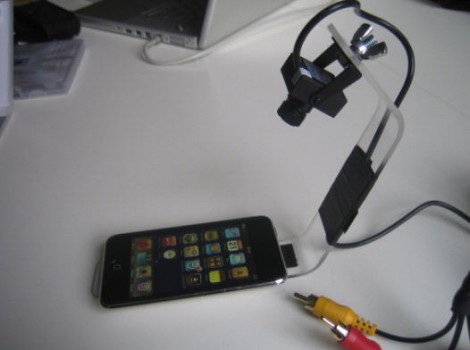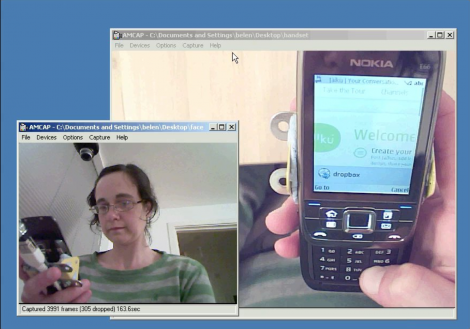Off the shelf mobile usability testing kit is ridiculously expensive. I’ve previously I’ve written about cheap ways to make usability testing “sleds” for your mobile devices. One of the simplest solutions was suggested by New Zealand-based UX expert Nick Bowmast, who recommends using a rectangular piece of acrylic, bent to shape over a household toaster, as shown below:

Image credit: Nick Bowmast.
So, the question is, how can you simultaneously record footage from the device camera with picture-in-picture footage of the user’s face from another camera – without spending a fortune?
I didn’t have an answer for that until I saw Belén Barros Pena and Bernard Tyers’ EuroIA presentation. They recommend using a $19 app called AMCap allows you to view two webcams simultaneously on your PC’s screen. You can then use any screen recording app (e.g. Camstudio) to capture your screen and audio to a video file.

Image credit: Belén Barros Pena and Bernard Tyers.
Admittedly, it’s not a beautiful solution, but it’s quick, cheap and effective. One for the Guerilla Mobile Usability Testing handbook!
Great post, Harry.
We actually posted about this over on the HumanCentric blog:
http://blog.humancentric.com/record-two-camera-feeds-using-only-free-software/
We were able to do two cameras for free and make the final recording look somewhat nice.
Hiya Harry. Thanks for the mention, but you might have overcooked it calling me an expert.
With handheld and touch screen devices you do need both cameras to realistically convey the expedience and interaction, so a mixer, Morae or the software you mention is required, but you don’t want your camera setup to change the way people hold or interact with the device, especially with switching between landscape and portrait.
I’ve recently made filming setups for capturing tablet use during UX research projects with iPad apps etc. and went through a fair bit of trial and error.. including these two…
1. Head mounted cameras free the device of ‘strap-ons’ but the moderator becomes the star of the show when participants eyeball you instead of the device as they tell their story.
2. Mounting the user-facing camera on the handheld device sounds like an option, but you end up with seasickness-inducing footage.
I ended up making a custom iPad filming rig which seemed to do the trick nicely.
As an alternative you can try mounting a webcam on a boom between the participant and the device and asking the participant to ‘hold it roughly in this area please’ to keep it in shot.
I have always used Morae for two webcams because to me setting up and getting results have always been pain free. The biggest problem I have found as Nick has said is how people hold the device, changing between landscape and portrait orientation is something I would love to see a solution for. I have set up over the shoulder filming but asking a participants to hold the device in a certain area is something I feel is unnatural. Filming the mobile device and how the participant picks it up, holds it and moves it is what I would like to observe and present to my clients
Great solution, definitely looks nicer than ones I’ve used in the past. Everything from IKEA desk lamps to car dashboard phone holders have done the trick for me.
The biggest problem isn’t recording 2 streams, it’s broadcasting them to remote teams at the same time – with 2 camera feeds, Quicktime Recorder, and either Ustream or GoToMeeting running, my poor (brand new!) MacBook Pro slows to a crawl.
We’ve taken to using 2 computers to reduce lag, but it’s still not ideal.
Thoughts?
Felix, in the past I’ve used a really, really long VGA cable and mirrored the display on the test computer for the viewing room. For the audio, I’ve used a separate microphone in the testing room connected to an amp and speakers in the viewing room. Low tech, but it works if the rooms are adjascent. You need a push-hole between the two rooms or at least a gap under the doors to run the cables through!
Fabulous! I love new ideas for how to record iphones, android devices, ipads, etc.
I think Morae is too expensive for what it does.
Here’s what I did with a banana holder (less glam than the acrylic molded over a toaster!) and existing equipment and software I had on hand to do recording on a Mac (looks like AmCap is Windows only and Camtasia is much more expensive than Silverback for recording picture in picture video)
http://www.flickr.com/photos/lwaldal/4900501706/
Hey Harry, wanted to give you a follow up to the sled you inspired us to build. Check it out.
http://twitpic.com/3673d5
Best,
KH
Pingback: PhDblog.co.uk » Meeting #9
Pingback: More mobile usability testing sleds… | 90 Percent Of Everything